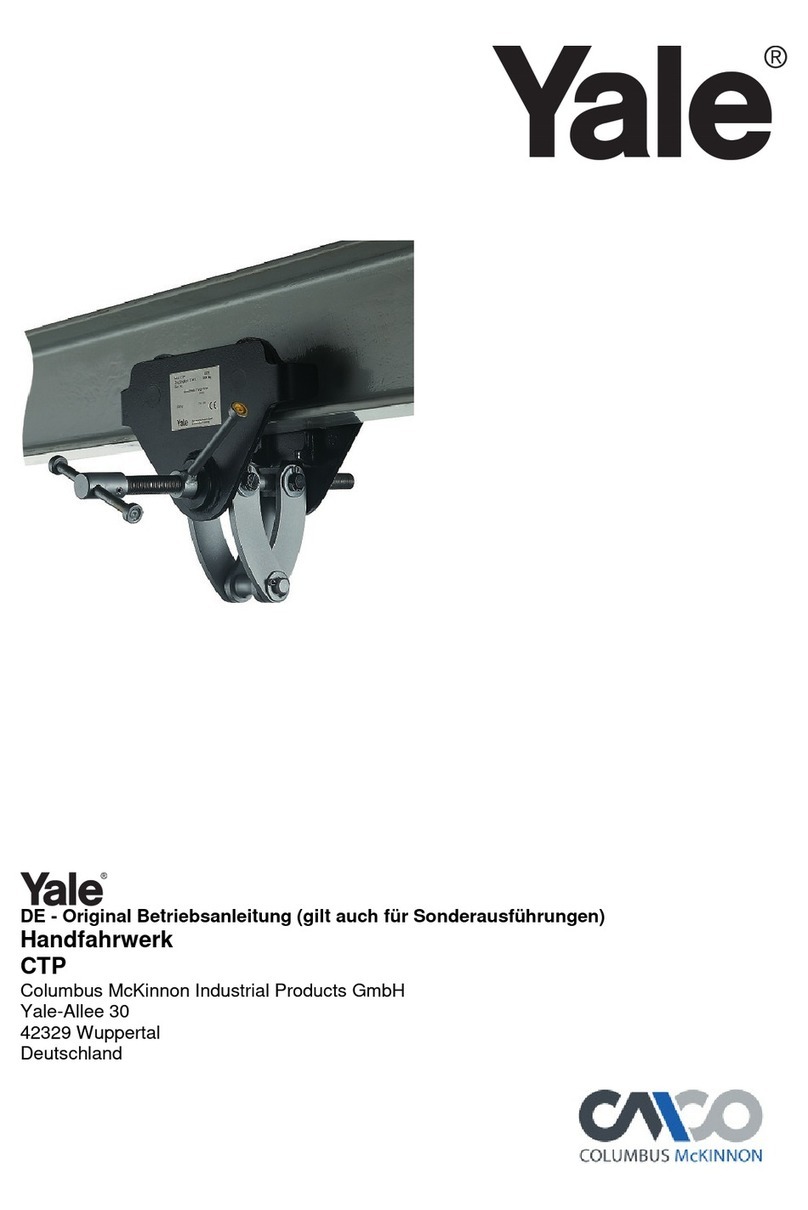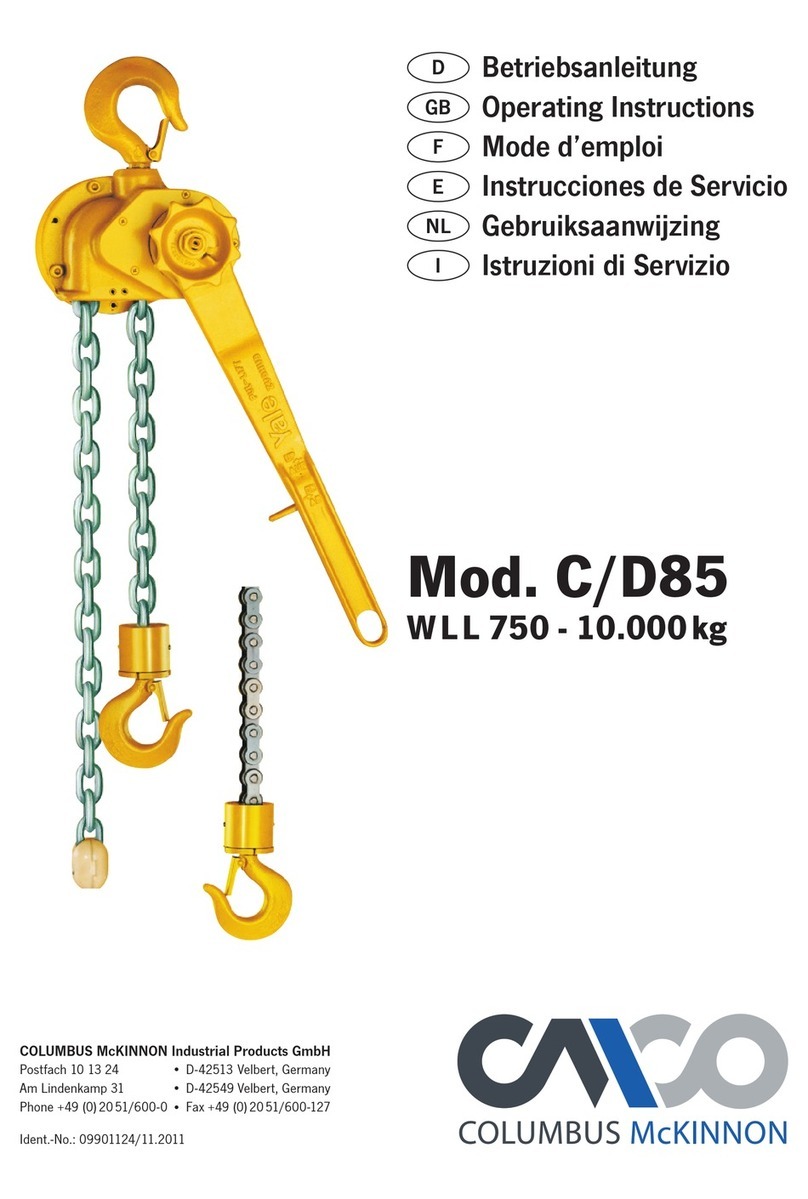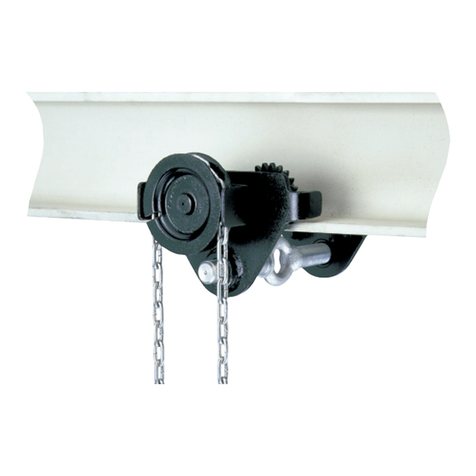
6 von 16
English
INTRODUCTION
Products of CMCO Industrial Products GmbH
have been built in accordance with the state-
of-the-art and generally accepted engineering
standards. Nonetheless, incorrect handling
when using the products may cause dangers
to life and limb of the user or third parties
and/or damage to the hoist or other property.
The operating company is responsible for
the proper and professional instruction of
the operating personnel. For this purpose, all
operators must read these operating instruc-
tions carefully prior to the initial operation.
These operating instructions are intended to
acquaint the user with the product and enable
him to use it to the full extent of its intended
capabilities. The operating instructions contain
important information on how to operate the
product in a safe, correct and economic way.
Acting in accordance with these instructions
helps to avoid dangers, reduce repair costs
and downtimes and to increase the reliability
and lifetime of the product. The operating
instructions must always be available at the
place where the product is operated. Apart
from the operating instructions and the ac-
cident prevention act valid for the respective
country and area where the product is used,
the commonly accepted regulations for safe
and professional work must also be adhered
to. The personnel responsible for operation,
maintenance or repair of the product must
read, understand and follow these operating
instructions.
The indicated protective measures will only
provide the necessary safety, if the product
is operated correctly and installed and/or
maintained according to the instructions. The
operating company is committed to ensure
safe and trouble-free operation of the product.
CORRECT OPERATION
- The hoist is used for overhead horizontal
moving of suspended loads up to the indi-
cated max. load capacity.
- Any different or exceeding use is con-
sidered incorrect. Columbus McKinnon
Industrial Products GmbH will not accept
any liability for damage resulting from
such use. The risk is borne by the user
or operating company alone.
- The load capacity indicated on the unit is the
maximum working load limit (WLL) that may
be attached.
- The selection and calculation of the appropri-
ate supporting structure are the responsibil-
ity of the operating company.
EN - The hoist is suitable for a wide range of
beams as well as for various profiles (e.g.
INP, IPE, IPB, etc.) with a max. inclination
of the beam flange which does not exceed
14°.
- The runway and its supporting structure
must be designed for the maximum loads
to be expected (deadweight of the unit +
load capacity). The runway must only have
a deflection of max. 1/500 of the span.
- The longitudinal gradient of the travel path
surface may not exceed 0.3%.
- The air gap between the wheel flange and
the beam flange („dimension A“) must range
between 1.0 and 2.5 mm on either side of
the trolley (depends on model, see Tab. 1).
- Once the trolley width has been adjusted, the
clevis of the load bar (Fig.6) must be in the
illustrated position relevant to the beam. The
top hook of the hoist must only be hung into
the clevis in this condition. The weight of the
hoist automatically secures the adjustment
of the trolley.
- The operator must ensure that the hoist is
suspended in a manner that makes it pos-
sible to operate the unit without exposing
himself or other personnel to danger by the
unit itself, the suspension or the load.
- The operator may start moving the load only
after it has been attached correctly and all
persons are clear of the danger zone.
- Do not allow personnel to stay or pass under
a suspended load.
- A lifted or clamped load must not be left
unattended or remain lifted or clamped for
a longer period of time.
- Loads suspended from a trolley without a
gear drive must be pushed. The load must
not be pulled.
- If the area in front of the load is not suffici-
ently visible, the operator must ensure he is
given help.
- The hoist may be used at ambient tempera-
tures between –10 °C and +50 °C.
Consult the manufacturer in the case of
extreme working conditions.
- Prior to operation of the hoist in special
atmospheres (high humidity, salty, caustic,
alkaline) or handling hazardous goods (e.g.
molten compounds, radioactive materials),
consult the manufacturer for advice.
- Always transport the load in the horizontal
direction slowly, carefully and close to the
ground.
- Only use safety hooks with safety latches.
- For attaching a load, only approved and
certified lifting tackle must be used.
- Correct operation involves compliance with
the operating instructions and in addition
also compliance with the maintenance
instructions.
- In case of functional defects or abnormal
operating noise, stop using the hoist imme-
diately.
INCORRECT OPERATION
(List not complete)
- Do not exceed the rated load capacity (WLL)
of the unit and/or the suspension and the
supporting structure.
- Removing or covering labels (e.g. by adhe-
sive labels), warning information signs or the
identity plate is prohibited.
- When transporting loads ensure that the load
does not swing (Fig.2) or come into contact
with other objects.
- The load must not be moved into areas which
are not visible to the operator. If necessary,
he must ensure he is given help.
- The unit must never be operated with more
than the power of a person.
- Welding work on the unit is prohibited. The
unit must never be used as a ground con-
nection during welding (Fig.3).
- Side pull, i. e. side loading of the side plates
and/or the load bar (Fig.4) is forbidden. The
trolley must be perpendicular above the load
at any time (Fig.1).
- A unit changed without consulting the
manufacturer must not be used.
- Do not use the hoist for the transportation
of people (Fig.5).
- Loads must not be turned in normal opera-
tion, since the trolley has not been designed
for this purpose and the wheel flanges may
be pressed against the beam flange (danger
of spark formation!). If loads must be turned
in normal operation, an anti-twist swivel
must be used or the manufacturer must be
consulted.
- Incorrect attachment to or incorrect loading
of the clevis load bar, i. e. applying load to
the “flat” side of the suspension eye, is
forbidden (Fig. 6).
- Enlarging the adjusted trolley width, e. g. to
enable the trolley to negotiate smaller curve
radii, is forbidden.
- Only units fitted with hooks with safety
latches must be suspended in the clevis of
the load bar. Make sure that the hook is not
too large. The clevis must be seated centrally
in the saddle of the hook and the hook must
be freely articulating in the clevis at the same
time.
- Only one load lifting attachment or hoist may
be suspended in the clevis of the trolley load
bar.
- Never reach into moving parts.
- Do not allow the unit to fall from a large
height. Always place it properly on the
ground.






























